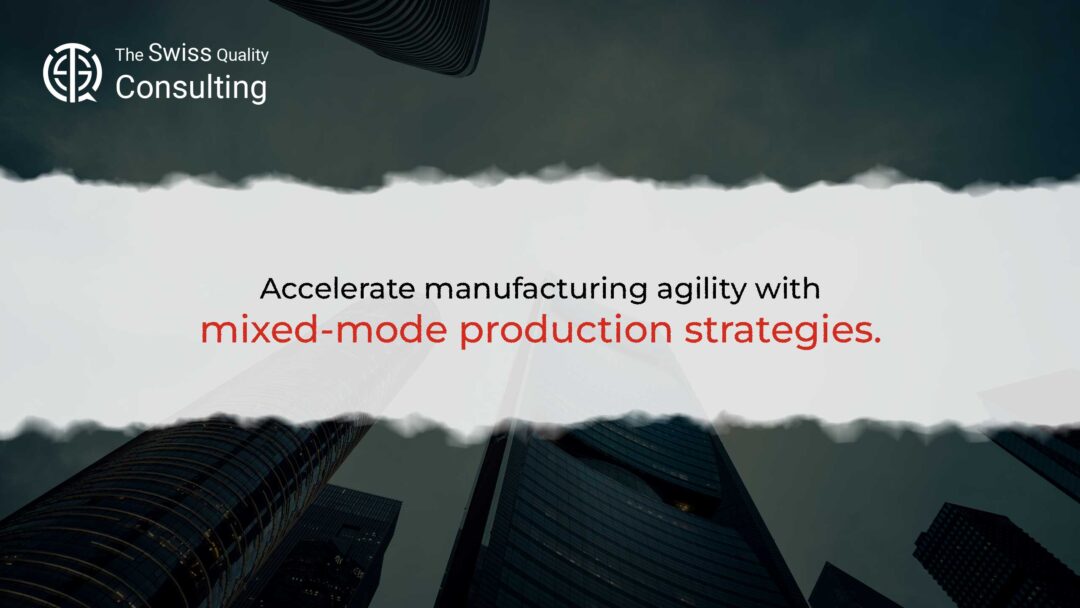Enhancing Manufacturing Efficiency through Mixed-Mode Production: Accelerate Manufacturing Agility with Mixed-Mode Production Strategies
In the competitive world of manufacturing, accelerating manufacturing agility with mixed-mode production strategies is essential for businesses aiming to adapt quickly to market demands and customer needs. This article, directed towards business executives, mid-level managers, and entrepreneurs, will delve into how mixed-mode production strategies can be a game-changer for manufacturing efficiency and overall business success.
Understanding Mixed-Mode Production in Manufacturing
Mixed-mode production emerges as a transformative approach to manufacturing, seamlessly blending the efficiency of traditional production methods with the agility and flexibility demanded by modern markets. This innovative methodology combines various manufacturing processes and methodologies, including discrete manufacturing, process manufacturing, and assembly-to-order systems, to create a hybrid production environment that can effectively cater to diverse product demands and fluctuating market conditions.
In contrast to traditional single-mode production systems, which are often optimized for a specific product type or production volume, mixed-mode production embraces the dynamism of the modern marketplace. By incorporating multiple production processes and methodologies, manufacturers can seamlessly shift between different product lines, adjust production volumes, and adapt to changing customer requirements. This inherent flexibility empowers manufacturers to respond swiftly to market trends, seize emerging opportunities, and maintain a competitive edge in a rapidly evolving business landscape.
Mixed-mode production not only enhances agility but also fosters operational efficiency and cost optimization. By leveraging the strengths of different manufacturing processes, manufacturers can streamline production workflows, minimize waste, and optimize resource utilization. For instance, discrete manufacturing techniques, often employed for high-volume production of standardized products, can be integrated with assembly-to-order systems to cater to customized or low-volume product demands. This seamless integration ensures that production processes are tailored to the specific requirements of each product line, maximizing efficiency and minimizing unnecessary costs.
Moreover, mixed-mode production facilitates effective inventory management, reducing the risk of stockouts and overstocking. By combining make-to-stock (MTS) and make-to-order (MTO) approaches, manufacturers can balance the production of anticipated demand items with the flexibility to respond to customized orders. This hybrid approach ensures that inventory levels are optimized, minimizing the carrying costs associated with excess inventory while maintaining the ability to fulfill customer orders promptly.
In essence, mixed-mode production revolutionizes the manufacturing landscape, empowering businesses to navigate the complexities of modern markets with newfound agility and efficiency. By embracing this innovative approach, manufacturers can effectively manage diverse product demands, adapt to changing market conditions, and achieve operational excellence, propelling their businesses towards sustainable growth and success.
Benefits of Mixed-Mode Production
Adopting mixed-mode production offers several advantages, including improved operational efficiency, better resource utilization, and the ability to cater to a wider range of customer demands. It enables manufacturers to switch between make-to-stock, make-to-order, and engineer-to-order production methods as needed.
The Role of Change Management in Implementing Mixed-Mode Production
Effective change management is crucial for the successful implementation of mixed-mode production strategies. It involves preparing the organization for change, managing the transition from traditional to mixed-mode production, and ensuring that all stakeholders understand and embrace the new approach.
Executive Coaching for Strategic Manufacturing Leadership
Executive coaching can play a vital role in equipping leaders with the skills and knowledge required to effectively manage the shift to mixed-mode production. Coaching focuses on developing strategic thinking, decision-making, and leadership skills tailored to the dynamic manufacturing environment.
Leveraging Generative AI in Mixed-Mode Production
Generative Artificial Intelligence (AI) can significantly enhance mixed-mode production strategies. AI-driven analytics and machine learning algorithms can optimize production planning, manage inventory efficiently, and predict market trends, aiding in making informed decisions.
Effective Communication in Manufacturing Transformation
Clear and effective communication is paramount during the transition to mixed-mode production. It ensures that everyone in the organization is aligned with the new manufacturing strategy and contributes to its successful implementation.
Project Management in Mixed-Mode Manufacturing
Applying robust project management techniques is essential in overseeing the transition to mixed-mode production. This includes setting clear goals, establishing timelines, allocating resources efficiently, and monitoring the implementation process to ensure that the transition is smooth and effective.
Conclusion: The Path to Agile Manufacturing
In conclusion, adopting mixed-mode production strategies is a strategic move for manufacturers seeking to enhance agility and remain competitive. By embracing effective change management, leveraging generative AI, and fostering clear communication, manufacturing businesses can successfully implement these strategies and achieve significant improvements in efficiency and responsiveness.
#ManufacturingAgility #MixedModeProduction #BusinessEfficiency #ChangeManagement #ExecutiveCoaching #GenerativeAI #ProjectManagement

